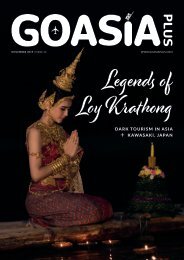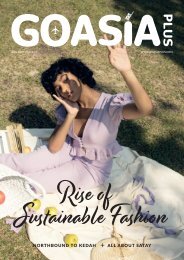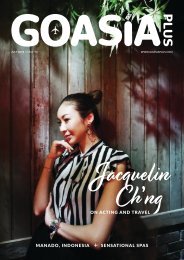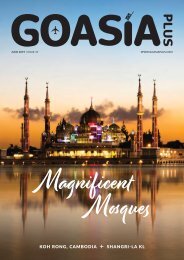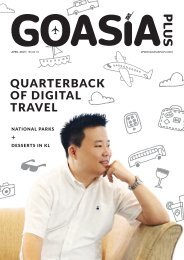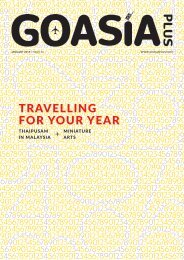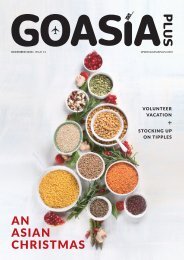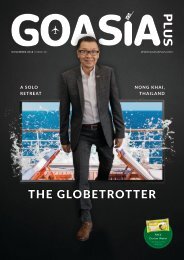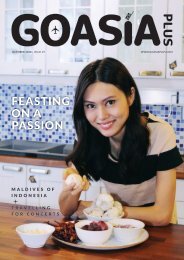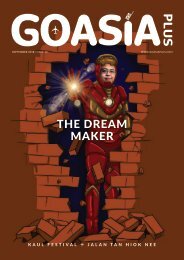GOASIAPLUS January 2018
You also want an ePaper? Increase the reach of your titles
YUMPU automatically turns print PDFs into web optimized ePapers that Google loves.
Kopitiam Culture<br />
I<br />
used to hear my father calling out loud, “Kopi O Kau” (strong brewed coffee) to the waiter<br />
every time he visited the kopitiam (coffee shop) when I was young. With three cups of “Kopi O<br />
Kau” daily, it is not surprising my 82-year old father is known as the “Kopi O King” among his<br />
friends. Today, he is probably one of the old generation of coffee connoisseurs who still prefer<br />
the authentic black coffee over the frothy-textured one.<br />
“I still love the original black Kopi O Kau compared to what you young people love. Latte,<br />
cappuccino and now what… frappuccino?” he teased me as I told him I will be whipping up a<br />
story on kopitiam culture.<br />
Sharing his sentiment is Lee Chew Boey who manages the renowned Sin Hoy How Kopitiam<br />
in Kuala Lumpur. “Your father is right. My old customers love the original black coffee while the<br />
younger ones will go for the frothy coffee or cappuccino,” she says.<br />
Sin Hoy How Kopitiam was established in 1937 by her father, Lee Kah Kiat and it is now one<br />
of the few surviving authentic kopitiams in the heart of Kuala Lumpur. After taking a sip of the<br />
kopitiam’s signature drink, “Kopi O Kau”, I must admit it is the finest full-bodied smooth coffee<br />
I have ever tasted. There is no better way to unlock the story of kopitiam with Lee Chew Boey<br />
while enjoying the intoxicating aroma and real taste of “Kopi O Kau” itself.<br />
CLOCKWISE FROM LEFT The<br />
spread of local cuisine at Sin<br />
Hoy How; The exterior of<br />
Sin Hoy How; Fresh ground<br />
coffee prepped to pack;<br />
The fully packed coffee<br />
powder; Coffee served in<br />
traditional tea cups; Coffee<br />
strained directly from the<br />
flannel sock strainer.<br />
KOPITIAM CULTURE<br />
Kopitiam is part of the rich culture and history<br />
of Malaysia. Waking up to a cup of coffee with<br />
a toast of kaya and butter, and half-boiled<br />
eggs has been the daily morning ritual of<br />
Malaysians everywhere.<br />
The history of kopitiam can be traced<br />
back in the late 18th century with the influx<br />
of Chinese immigrants to Malaya. As they<br />
mingled with the locals and the Europeans,<br />
they gradually developed a love for coffee and<br />
thus, kopitiam was born.<br />
Soon, kopitiams flourished and became<br />
the place for the community to hang out, from<br />
playing chess to spending hours chit-chatting<br />
about politics and other issues.<br />
LEGACY CONTINUES<br />
With more foreign coffee franchises such as<br />
Starbucks, Coffee Bean and others making<br />
their presence felt, one would have easily<br />
thought the kopitiams will not survive.<br />
But today, the old kopitiams are given a<br />
new lease of life, even turning into franchises<br />
like Old Town White Coffee, Kluang Station,<br />
Uncle Lim’s Café and many more.<br />
For Sin Hoy How Kopitiam, it still<br />
preserves its coffee authenticity. “We still use<br />
the old boiler and flannel sock to make our<br />
coffee. In fact, we still have our own brand<br />
of coffee powder. Best of all, our kopitiam is<br />
family-run and not another franchise,” Lee<br />
Chew Boey says with a proud smile.<br />
30 · WWW.<strong>GOASIAPLUS</strong>.COM




